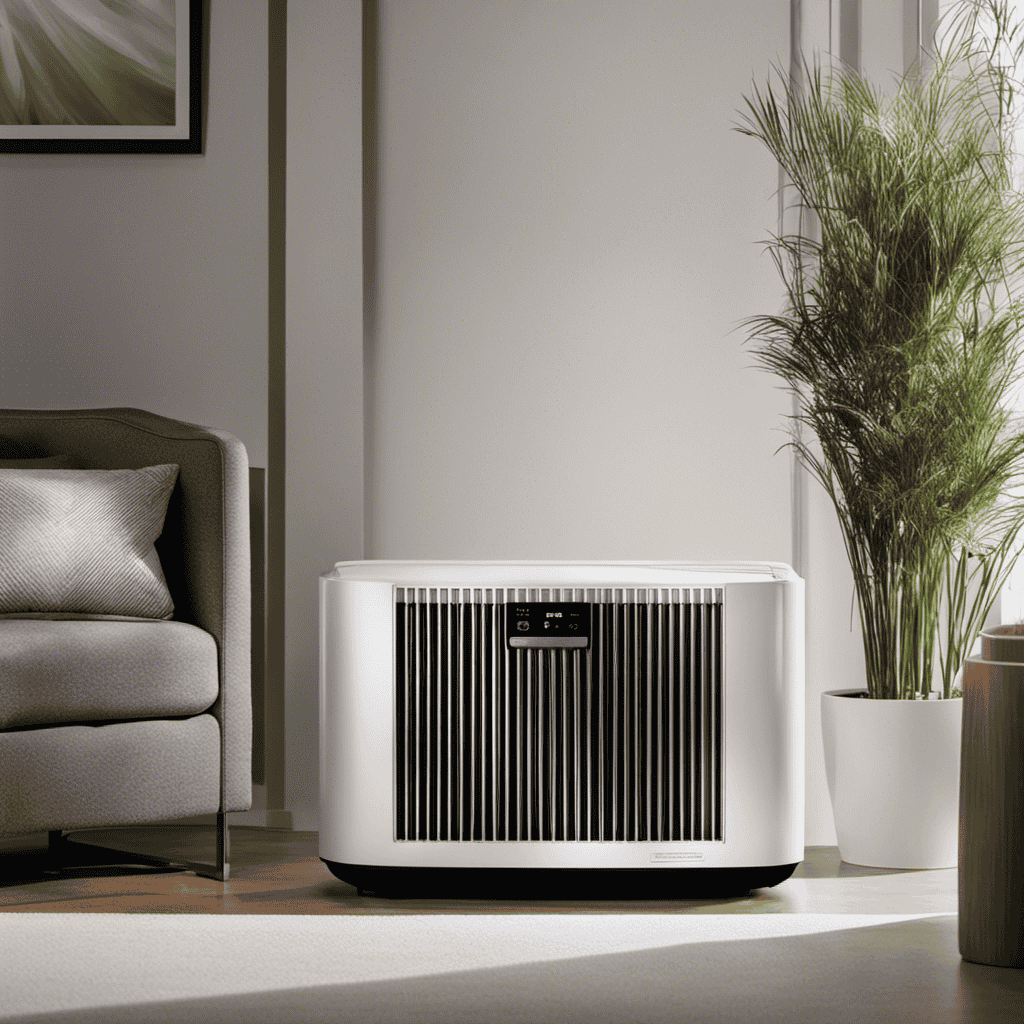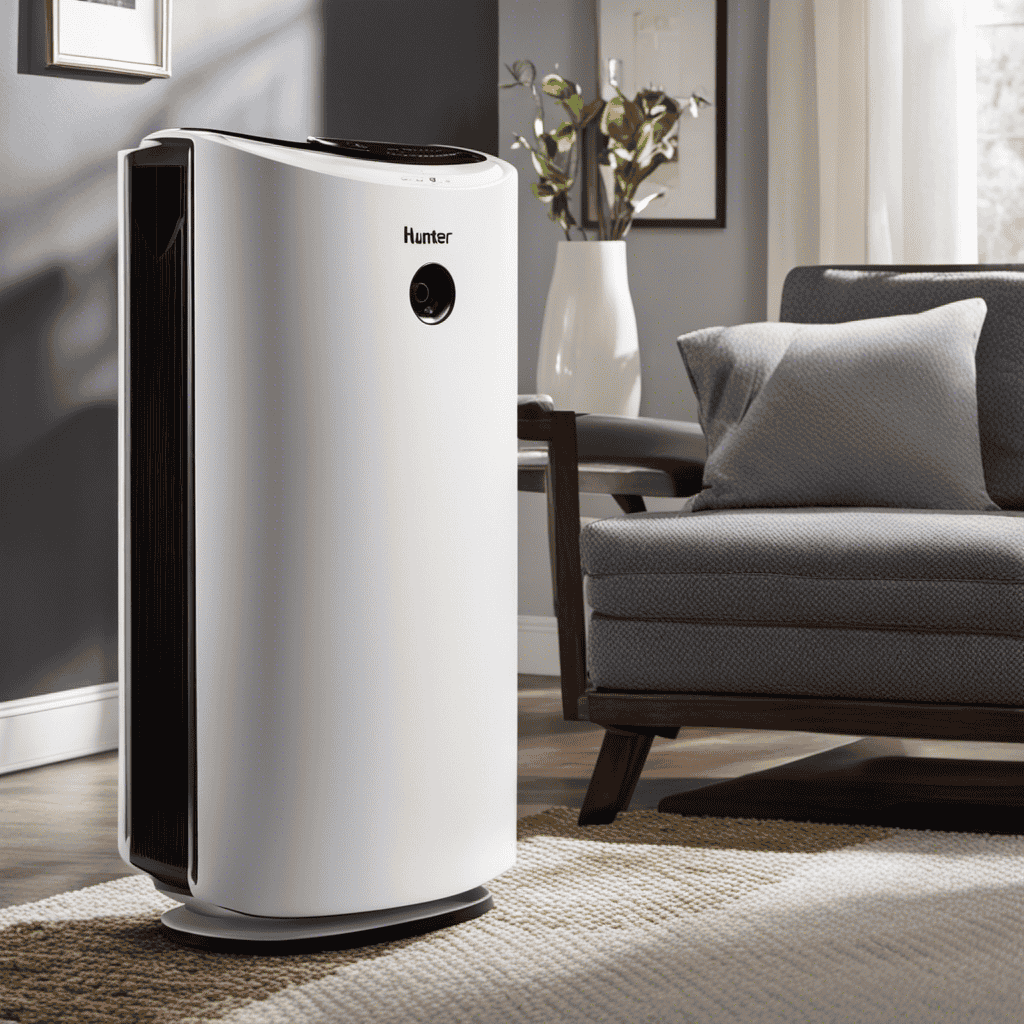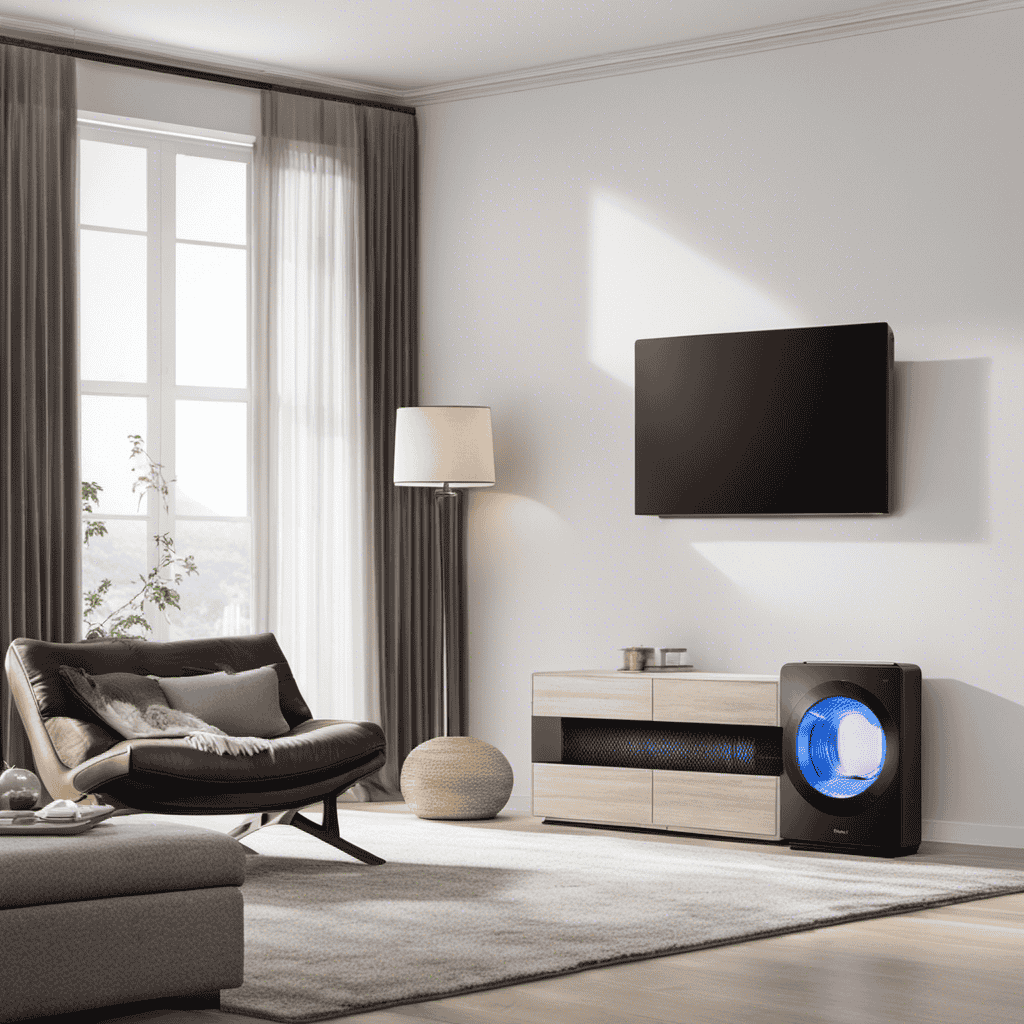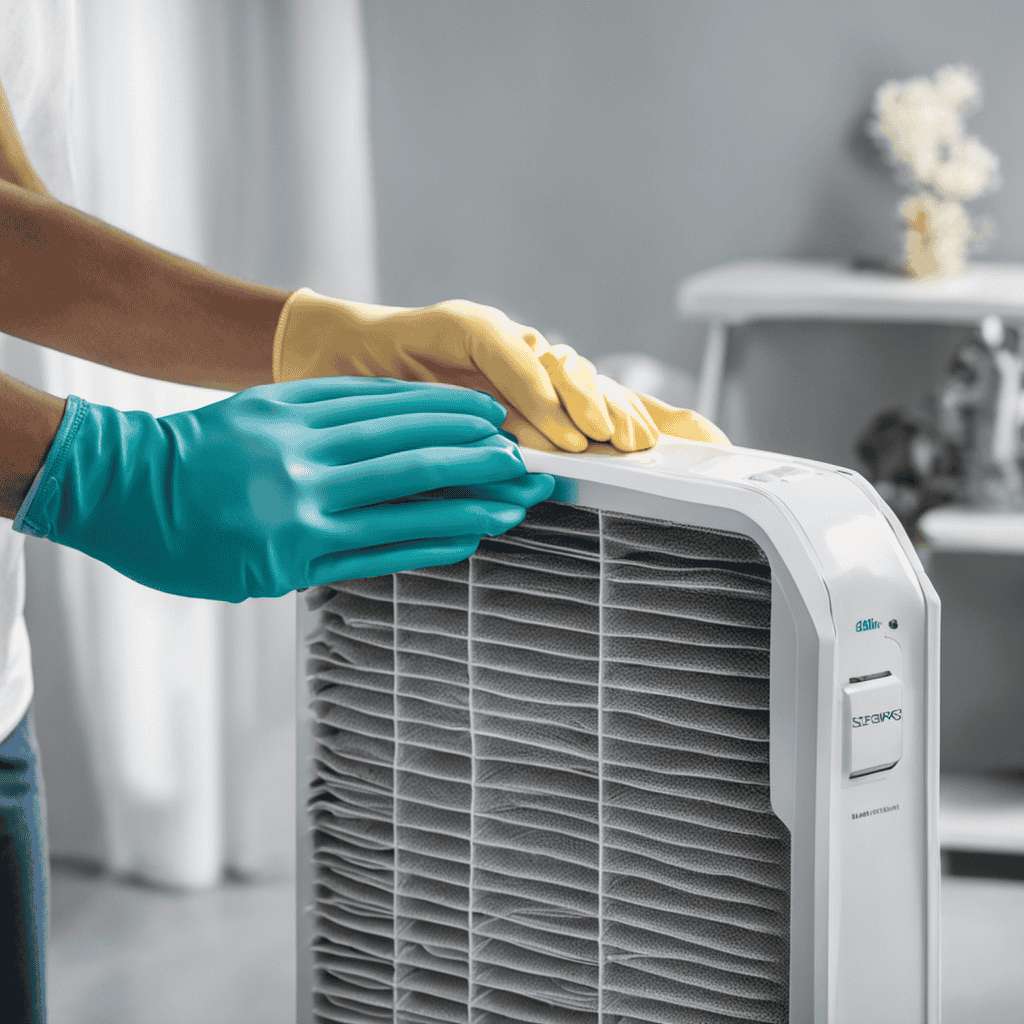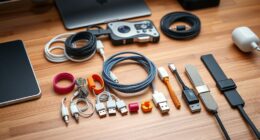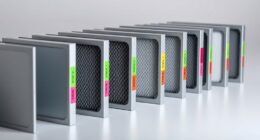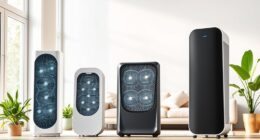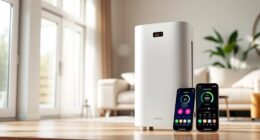As a homeowner, I understand the significance of maintaining clean and fresh air inside my house. That’s why I depend on my electrostatic air purifier.
But when should I clean it? In this article, I will guide you through the signs that indicate your electrostatic air purifier needs cleaning, the frequency at which you should clean it, and the common mistakes to avoid.
With my step-by-step guide, you’ll have a thorough understanding of when and how to clean your electrostatic air purifier for maximum effectiveness.
Key Takeaways
- Regular cleaning is essential for maintaining the effectiveness of electrostatic air purifiers.
- Signs of dirty filters, such as visible dust and debris buildup, indicate the need for cleaning.
- Factors affecting the cleaning schedule include the level of air pollution, number of occupants, and environmental conditions.
- Cleaning electrostatic air purifiers improves air quality, removes contaminants and odors, and prolongs the lifespan of the purifier.
Signs That Your Electrostatic Air Purifier Needs Cleaning
If you notice a decrease in air quality or an increase in dust and particles in your home, it’s likely that your electrostatic air purifier needs cleaning.
Regular cleaning of your electrostatic air purifier is essential to maintain its effectiveness in improving indoor air quality.
The optimal cleaning method for electrostatic air purifiers involves removing the collection plates and washing them with warm soapy water. It is important to rinse the plates thoroughly to ensure all dirt and debris are removed.
Additionally, the outer casing of the air purifier should be wiped down with a damp cloth to remove any dust or buildup.
Regular cleaning not only improves the efficiency of your air purifier but also prolongs its lifespan.
Frequency of Cleaning for Electrostatic Air Purifiers
When it comes to maintaining optimal air quality in your home, understanding the frequency of cleaning for electrostatic air purifiers is crucial.
A key point to consider is the optimal cleaning schedule for these devices, as it can vary depending on factors such as the level of air pollution in your area and the usage of the purifier.
Additionally, being able to identify signs of dirty filters is important, as it indicates when cleaning is necessary to ensure the continued effectiveness of the purifier in removing pollutants from the air.
Optimal Cleaning Schedule
The optimal cleaning schedule for an electrostatic air purifier includes regular maintenance and filter replacement. To keep your air purifier running efficiently and effectively, here are some key points to consider:
-
Optimal Cleaning Products:
-
Use a mild detergent or soap to clean the exterior of the purifier.
-
Avoid using harsh chemicals or abrasive cleaners that can damage the unit.
-
Cleaning Techniques:
-
Gently wipe down the exterior surfaces with a soft cloth or sponge.
-
Clean the pre-filter regularly by vacuuming or rinsing it under running water.
-
Replace the filter as recommended by the manufacturer to ensure optimal performance.
Following these cleaning practices will not only maintain the functionality of your air purifier but also contribute to cleaner and healthier indoor air. Remember, proper maintenance is crucial for the longevity and effectiveness of your electrostatic air purifier.
Factors Affecting Cleaning Frequency
To determine how often you should clean your electrostatic air purifier, consider factors such as the level of air pollution in your environment and the number of occupants in your space. These factors can greatly affect the rate at which your filters become dirty and clogged.
If you live in a highly polluted area or have a large number of people in your home, it’s likely that your filters will become dirty more quickly. Regular cleaning is essential to maintain the efficiency of your air purifier and ensure clean air in your space.
Optimal cleaning methods can vary depending on the model of your purifier, but generally involve removing the filters and gently washing them with water or using a vacuum cleaner. Proper cleaning and maintenance can help prolong the lifespan of your filters and keep your air purifier working effectively.
With that being said, it’s important to know the signs of dirty filters, which we will discuss in the next section.
Signs of Dirty Filters
If you notice reduced airflow or a musty smell in your space, it’s likely that your filters are dirty and need to be cleaned. Checking filters regularly is crucial for maintaining the efficiency of your air purifier and ensuring clean and fresh air in your environment.
Here are some signs that indicate it’s time to clean your filters:
- Visible dust and debris buildup on the filters
- Increased allergy or asthma symptoms
- Reduced effectiveness of the air purifier in removing odors
- Higher electricity bills due to decreased airflow
- A decrease in the overall performance of the air purifier
To clean your filters effectively, follow these cleaning techniques:
- Turn off the air purifier and unplug it from the power source.
- Remove the filters and gently tap them to remove loose dirt and debris.
- Use a soft brush or vacuum cleaner to remove stubborn dirt and dust.
- If the filters are washable, rinse them under running water.
- Allow the filters to dry completely before reinserting them into the air purifier.
Regularly checking and cleaning your filters will help maintain the performance and lifespan of your air purifier, ensuring clean and healthy air in your space.
Factors That Can Affect the Cleaning Schedule for Electrostatic Air Purifiers
When it comes to maintaining and cleaning electrostatic air purifiers, there are a few key factors to consider.
Firstly, environmental conditions play a significant role in determining how often these devices should be cleaned. Factors such as the level of air pollution, presence of pet dander or smoke, and overall air quality can impact the cleaning schedule.
Additionally, the frequency and maintenance requirements of electrostatic air purifiers may vary depending on the specific model and brand, so it is important to refer to the manufacturer’s guidelines for proper maintenance procedures.
Environmental Conditions and Cleaning
You can determine the need to clean your electrostatic air purifier by assessing the environmental conditions and inspecting its cleanliness. Here are some factors to consider and maintenance tips for optimal cleaning solutions:
- Environmental Conditions:
- Dust and Pollen Levels:
- High levels of dust and pollen in the air can clog the air purifier’s filters, reducing its effectiveness.
- Regularly check the filters for excessive build-up and clean or replace them as needed.
- Pet Hair and Dander:
- If you have pets, their hair and dander can accumulate on the purifier’s surfaces.
- Wipe down the exterior regularly to prevent build-up and ensure proper airflow.
Cleaning Tips:
- Follow the manufacturer’s instructions for cleaning and maintenance.
- Use a soft, lint-free cloth and mild cleaning solution to clean the exterior of the purifier.
- Clean the filters regularly to maintain optimal performance.
Frequency and Maintenance Requirements
To maintain optimal performance, regularly inspect and clean the filters of your electrostatic air purifier. Cleaning the filters is an essential part of proper maintenance. Over time, these filters can become clogged with dust, allergens, and other particles, reducing the purifier’s effectiveness. By cleaning them regularly, you can ensure that your air purifier continues to provide you with clean and fresh air.
When it comes to maintenance tips for your electrostatic air purifier, there are a few key things to keep in mind. First, always consult the manufacturer’s instructions for specific cleaning techniques and frequency recommendations. Generally, it is recommended to clean the filters at least once every three months. However, if you live in a particularly dusty or polluted area, more frequent cleaning may be necessary.
To clean the filters, start by turning off and unplugging the air purifier. Gently remove the filters and use a vacuum cleaner with a brush attachment to remove any loose debris. For a more thorough clean, you can also wash the filters with warm water and mild soap. Allow the filters to dry completely before reinstalling them.
Regularly inspecting and cleaning the filters of your electrostatic air purifier is crucial for maintaining its performance and ensuring that you are breathing clean air. By following these maintenance tips and cleaning techniques, you can keep your air purifier running smoothly and efficiently.
How to Check if Your Electrostatic Air Purifier Needs Cleaning
If your electrostatic air purifier isn’t effectively removing dust and allergens, it’s probably time for a cleaning. Checking the efficiency of your air purifier is essential to ensure that it’s working at its best. Here are some troubleshooting tips to help you determine if your electrostatic air purifier needs cleaning:
- Check the airflow: If you notice a decrease in the airflow, it may indicate a clogged filter that needs cleaning.
- Inspect the filter: Look for visible dirt or debris on the filter surface. A dirty filter will hinder the purifier’s performance.
- Clean the filter: Following the manufacturer’s instructions, remove the filter and gently clean it. Ensure it’s completely dry before reinserting.
By regularly checking the efficiency of your electrostatic air purifier and troubleshooting any issues, you can maintain its optimal performance.
Now, let’s move on to the step-by-step guide to cleaning an electrostatic air purifier.
Step-By-Step Guide to Cleaning an Electrostatic Air Purifier
Now, let’s dive into the step-by-step process for cleaning an electrostatic air purifier.
Cleaning your electrostatic air purifier regularly is crucial for maintaining its optimal performance.
To begin, make sure to disconnect the power supply and remove the air purifier’s collection plates.
Gently rinse the plates with warm water and a mild detergent, ensuring that all dirt and debris are removed.
Avoid using abrasive materials or harsh chemicals, as they can damage the plates.
After cleaning, thoroughly dry the plates before reinserting them into the air purifier.
Additionally, it is important to troubleshoot common cleaning issues such as a decrease in performance or an accumulation of dust on the plates.
If these problems persist, consult the manufacturer’s manual or contact customer support for further assistance.
Common Mistakes to Avoid When Cleaning Electrostatic Air Purifiers
Make sure you don’t forget to disconnect the power supply and remove the collection plates before cleaning the electrostatic air purifier. Cleaning an electrostatic air purifier can be a straightforward task, but there are some common mistakes that you should avoid to ensure its effectiveness and longevity.
Here are a few things to keep in mind:
- Avoid using harsh chemicals or abrasive materials when cleaning the collection plates, as they can damage the delicate surface.
- Do not immerse the entire unit in water or submerge the collection plates. Instead, wipe them down gently with a damp cloth.
- Be cautious when handling the electronic components and ensure they are completely dry before reinstalling them.
Benefits of Regular Cleaning for Electrostatic Air Purifiers
Regular cleaning of electrostatic air purifiers is essential for maintaining their performance and extending their lifespan. This ensures clean and healthy air for you and your family. The benefits of regular maintenance cannot be overstated.
Firstly, cleaning the filters and collection plates removes accumulated dust, allergens, and other particles that can clog the system and hinder its efficiency. This allows the air purifier to effectively capture and remove pollutants, improving the quality of the air in your home.
Secondly, regular cleaning prevents the buildup of contaminants that can lead to unpleasant odors and potential health issues. By keeping the electrostatic air purifier clean, you are creating a healthier living environment for yourself and your loved ones.
Lastly, regular maintenance helps to prolong the lifespan of the air purifier, saving you money in the long run. So, don’t forget to clean your electrostatic air purifier regularly to enjoy these benefits and breathe easy.
Frequently Asked Questions
Can I Use Any Type of Cleaning Solution to Clean My Electrostatic Air Purifier?
Yes, you can use different cleaning methods for your electrostatic air purifier. However, it is recommended to use specific cleaning solutions that are safe and effective for maintaining the performance of the purifier.
Is It Necessary to Turn off My Electrostatic Air Purifier Before Cleaning It?
It’s important to regularly maintain your electrostatic air purifier to ensure it functions effectively. To maximize the lifespan of the filters, turn off the purifier before cleaning it.
Can I Clean the Filters of My Electrostatic Air Purifier in the Dishwasher?
Sure, you can clean the filters of your electrostatic air purifier in the dishwasher. However, it’s important to follow the manufacturer’s cleaning tips and maintenance guide to ensure proper cleaning and avoid any damage.
How Often Should I Replace the Filters in My Electrostatic Air Purifier?
I clean the exterior of my electrostatic air purifier every few weeks to keep it running efficiently. Signs that it needs cleaning include a decrease in air flow and a buildup of dust on the surfaces.
Can I Use Compressed Air to Clean My Electrostatic Air Purifier Instead of Washing It?
I’ve found that washing my electrostatic air purifier is the best way to keep it clean. While using compressed air may seem convenient, washing removes dirt and debris more effectively, ensuring optimal performance and healthier air quality.
Conclusion
In conclusion, regular cleaning is crucial for maintaining the efficiency and effectiveness of your electrostatic air purifier. By keeping it clean, you can ensure that it continues to remove airborne particles and improve the air quality in your home.
A study conducted by the Environmental Protection Agency (EPA) found that a dirty filter can reduce the airflow of an air purifier by up to 20%. This statistic emphasizes the importance of cleaning your electrostatic air purifier regularly to ensure optimal performance.
So, make sure to follow the recommended cleaning schedule and avoid common mistakes to keep your air purifier running smoothly.
